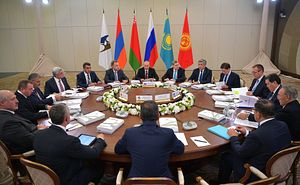The Eurasian Economic Union (EAEU or EEU*) turned three on January 1, 2018. With four founding members — Russia, Kazakhstan, Belarus and Armenia — the Union was formally established on January 1, 2015. Kyrgyzstan joined officially in August 2015 but since, no other states in Eurasia have made efforts to join.
For New Eastern Europe recently, Alexander Libman did a thorough job of asking, and then answering, “What does the Eurasian Economic Union (EAEU) actually do?”
As Libman notes, while the organization is prominent in scholarly and political debates, “many students of the EAEU do not study the organisation as such: they seem to be more interested in learning the place the Eurasian idea plays in the Russian foreign policy and rhetoric rather than understanding what exactly the EAEU as an international organisation is about.”
Guilty as charged.
The EAEU, as Libman and others have commented, is often discussed as an instrument of Russian power in Eurasia. At its founding, some even wondered (perhaps wildly so) if it was a first step in resurrecting the Soviet Union. But Kazakhstan — in fact, Nazarbayev suggested it first way back in 1994 — “is equally important which, in many cases, leads the organisation in a different direction from that intended by Russia.”
In this regard, Kataryna Wolczuk and Rilka Dragneva’s report for Chatham House last year (“The Eurasian Economic Union: Deals, Rules and the Exercise of Power”) makes the case that the EAEU “it is the primary vehicle for [Russia] realizing a global geopolitical agenda.” But, Wolczuk and Dragneva write, “satisfied with having created a union, Russia is not preoccupied with making it work.”
While the earlier paper examines the geopolitical angles of the Union, Libman’s recent analysis focuses first on the structural operations of the EAEU. Libman calls it a “limited customs union” which has “harmonised the external customs tariffs, abolished the internal customs borders, and transferred the decision-making about the tariffs to the Union level instead of individual member countries.”
The piece manages to balance the Union’s structural achievements with a discussion of its many problems.
For example, while abolishing internal constraints on labor mobility is an achievement of the Union and a boon for Armenia and Kyrgyzstan, the greatest contributors to Eurasia’s emigrant population — Tajikistan and Uzbekistan — are outside the Union.
The Union’s treaty, Libman says, “envisioned stepwise integration of a number of key markets – from medical products and electricity to oil and financial services,” but that in reality these goals are unrealistic given members’ inability to reach consensus.
Libman does not mention the kerfuffle last fall between Kazakhstan and Kyrgyzstan which saw Astana unilaterally impose greater customs restrictions on Bishkek. The long lines of trucks and rotting produce on the roadside was a clear signal that the open borders for trade within the EAEU were not so open.
He does, however, mention the impact of authoritarian style governments on decision-making processes:
Four out of five members of the EAEU (Russia, Kazakhstan, Belarus and Armenia) are authoritarian countries and their bureaucracies are trained in showing full and unconditional loyalty to the political leadership. They do not change this behavior after they are appointed to EAEU bodies. As a result, in case of even minor disagreements, bureaucrats prefer not to take any risk and shift the decisions to the political level (preferably that of the heads of states) rather than to make decisions themselves.
This constrains the organization in managing effectively the growing pains of forming a customs union as the treaty envisioned. At the same time, while this political failing impacts the Union’s functionality — the Union itself is not a political entity: “there are no references to any ideology in the EAEU documents, no political institutions like a common citizenship or parliament and no political goals.”
When it comes to what the future holds for the EAEU, Libman arrives at a similar conclusion as Wolczuk and Dragnev: that it will neither implode nor grow. Full collapse or “sliding into [a] purely rhetorical structure,” Libman writes, is unlikely, as unlikely as higher levels of economic integration.
Diverging from Wolczuk and Dragnev, who wrote that “[f]or Russia, the EAEU is the primary vehicle for realizing a global geopolitical agenda.” Libman says that the EAEU is no longer a “priority project” for Russia — pointing to the selection of Dmitriy Bel’yaninov as the CEO of the Eurasian Development Bank (part of the EAEU structure). The former head of the Russian customs, Bel’yaninov left that post under a cloud of corruption allegations. “Russia seems to return to the pattern it used in the 1990s: using the Eurasian regional organisations as a place of exile for politicians,” Libman writes.
Whither the EAEU? (To borrow an overused phrase usually reserved for the EU). The answer very well may be a degree of withering. Bureaucracies, once created, can be resilient in the sense that as long as member countries send diplomats — any diplomat will do — the organization keeps breathing. But flourishing seems out of the question whether one believes the EAEU is a tool of Russian geopolitics or an attempt at economic regionalism.
Note on acronyms: The Diplomat has used EEU since the Union’s founding, but academic circles have shifted to EAEU (to follow the official preferred acronym), perhaps to more clearly differentiate the Eurasian Economic Union from the European Union.

































